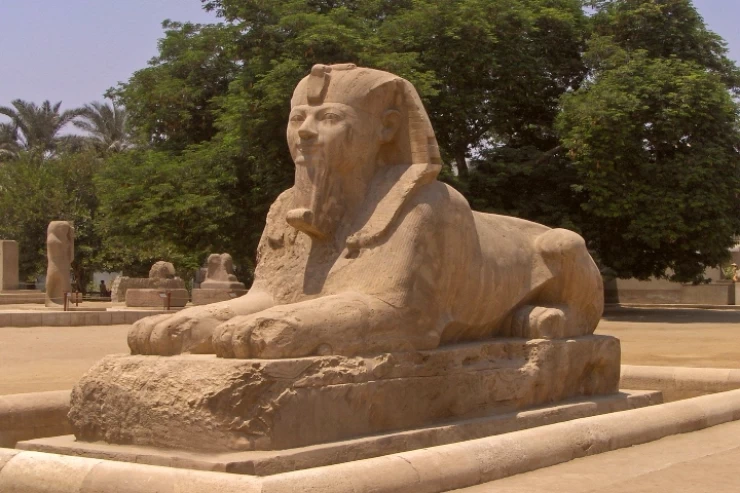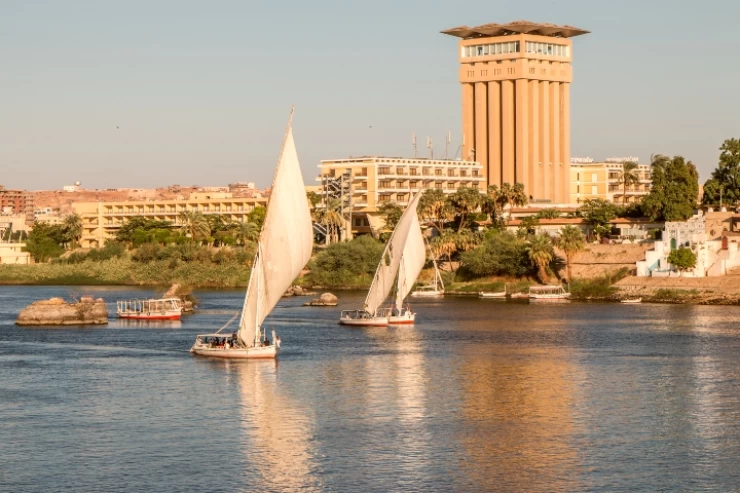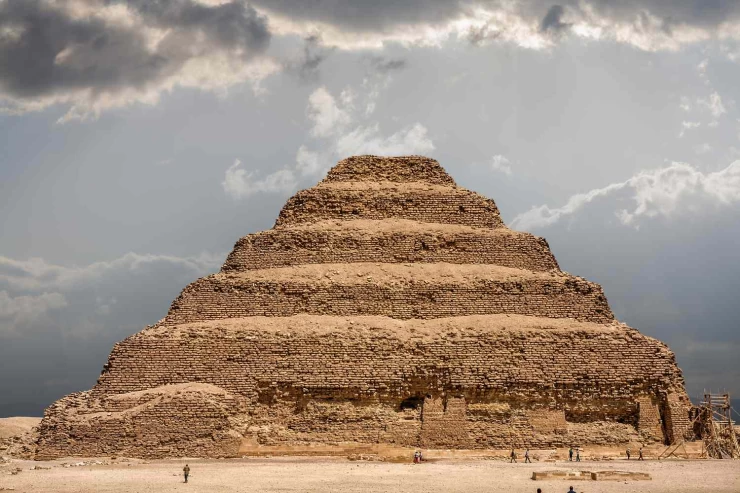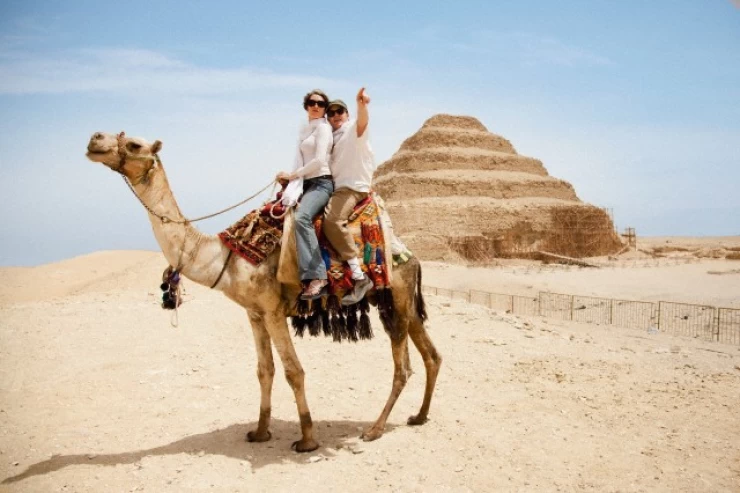
埃及古都孟菲斯
孟菲斯:埃及第一代国王的永恒之城
孟菲斯位于尼罗河西岸,开罗以南,是埃及最重要的历史和考古中心之一。自公元前 3100 年建立以来,这座古老的大都市作为埃及的首都存在了大约两千年,直到被底比斯和亚历山大城的强大所取代。鉴于孟菲斯建于埃及历史和文明的最早期,我们可以有把握地断定,孟菲斯不仅仅是一个行政和政治区域,而且还有活跃的宗教活动。如今,虽然大部分孟菲斯城已经消失多年,但为数不多的遗迹仍有助于人们拼凑出埃及丰富多彩的历史。
让我们带着探索孟菲斯之美和历史的使命,去探访那些历经时间考验的神话般的建筑、神庙和雕塑吧。
孟菲斯的诞生 历史概述
孟菲斯(古埃及人将其命名为 Ineb Hedj,英语译为 “白墙”)位于尼罗河三角洲,是尼罗河与巨大沙漠的交汇处,地理位置十分优越。这使它成为运输和贸易活动的中心,将埃及与地中海、非洲乃至几乎整个世界联系在一起。
没过多久,孟菲斯就成为了一座富裕的城市和埃及的管理、经济和艺术中心。在历史的长河中,孟菲斯经历了多个王朝的兴衰,埃及国王在此建造了宏伟而昂贵的宫殿、神庙和陵墓。这座城市的影响力一直持续到希腊罗马帝国统治时期,亚历山大港接管了权力中心,孟菲斯随着时间的推移开始失去其重要性。
孟菲斯的宗教意义: 一座神圣的城市
孟菲斯除了是政权所在地,还是整个古埃及世界的主要宗教中心之一。这里的主神普塔(Ptah)是负责创造和工艺的神,埃及各地都有许多供奉他的神庙和朝圣者。作为一个被动的创造者,“只通过一句话就能使事物存在”,这就不难理解为什么他在埃及诸神的等级制度中如此重要。城中最显赫的神庙普塔神庙供奉着这位神灵,吸引了大量来自埃及各地的游客和崇拜者。
后来,孟菲斯又出现了更多的神灵,如狮子头女神塞克梅特(Sekhmet)和莲花再生之神奈菲尔特姆(Nefertem)。他们还与普塔神一起被称为普塔家族,随着宗教活动的日益集中,他们加强了孟菲斯城的宗教活动。
孟菲斯的主要景点和纪念碑
如今,孟菲斯的大部分地区都已成为废墟,但无论留下什么,都能让人看到这座城市辉煌时期的缩影。以下是经受住时间考验的一些最著名的建筑:
1. 普塔神庙雕像
普塔神庙被视为孟菲斯所有神庙的中心,可以说是古埃及第二大神庙。该神庙在漫长的岁月中遭受了巨大损失,但考古发掘工作仍发现了其石柱、雕像和祭坛的痕迹。
神庙建筑群还包括几个由走廊连接的庭院、神龛和小礼拜堂组成的矩阵,祭司们在其中举行仪式和献祭。如今,游客们会注意到神庙内一些残缺的法老巨像,这些巨像展现了神庙的全貌。
2. 拉美西斯巨像
拉美西斯二世的巨大石灰石雕像是孟菲斯的著名纪念碑之一。据说这座雕像站立时有 30 多英尺高,雕像描绘的是法老大步流星的姿态,雕像上有国王头饰和服饰的多个细节,装饰十分精美。
目前,这座雕像横向陈列在孟菲斯博物馆中,观众可以更清楚地看到雕像的工艺和比例。孟菲斯的拉美西斯二世手持权杖的低矮古典风格雕像是埃及最伟大的国王之一,也是埃及最伟大的遗产之一。
3. 阿拉巴斯坦狮身人面像
阿拉巴斯坦狮身人面像位于拉美西斯二世巨大雕像的附近,是一件令人惊叹的艺术品,重约 80 吨,高约 13 英尺,长 26 英尺。据推测,它是在阿蒙霍特普二世统治时期(第十八王朝)制作的,人们认为它描绘的是阿蒙霍特普二世或他的继承人。
与用石灰石建造的吉萨大狮身人面像相比,雪花石膏狮身人面像是用一整块雪花石膏(一种甜美的半透明石头)制成的。它美观宁静,五官雕刻精湛,将埃及艺术的情感表现得淋漓尽致。
4. 霍伦希布墓
霍伦希布将军后来被封为国王,他被安葬在萨卡拉建筑群内的石棺中;不过,他与孟菲斯的关系更为密切。当图坦卡蒙坐在王位上的时候,他在城内担任指挥官的重要职务,因此对城内的走廊非常熟悉。图坦卡蒙的陵墓非常精美,墓前的浮雕刻满了他的胜利和伟大的战功。
这座陵墓提供了许多关于第十八王朝的相关信息,以及霍伦希布统治时期孟菲斯在艺术和文化方面的政治气候。
最新发现 发掘孟菲斯隐藏的宝藏
孟菲斯如今仍然是考古活动的热土,最近的发现为人们了解这座过去默默无闻的城市打开了新的窗口。在孟菲斯的多个历史时期都发掘出了古代雕像、石棺和其他艺术品的遗骸,这有助于人们了解世界的这一角落。
在近几年的高温季节,考古学家们挖掘出了大量塞克梅特的雕像,这意味着她和她的崇拜者们在孟菲斯的虔诚存在。此外,祭司和其他城市官员的墓穴以及负责为城市神庙提供服务的工匠的墓穴的发现也证明了有关他们生活的因素。
孟菲斯的遗产: 古都的兴衰
孟菲斯不仅是一个政治中心,也是一个文化和知识中心。这座城市吸引了许多艺术家、文士和学者,他们都在埃及的艺术和文学发展中发挥了作用。然而,在其他地区逐渐强大起来之前,孟菲斯的情况一直如此;管理机构先后迁往底比斯和亚历山大城,导致孟菲斯停滞不前。
v孟菲斯的经济衰退是缓慢发生的,但在罗马占领时期已经十分明显。随着亚历山大城作为主要教育和商业中心的崛起,孟菲斯的神庙和古迹受到了冷落,城市本身最终也被埋葬在尼罗河三角洲的流沙之下。
游览今日孟菲斯: 时光倒流
尽管孟菲斯古城的大部分已化为废墟,但对于那些对埃及历史感兴趣的人来说,这里仍是一个重要的地方。位于米特拉希纳(Mit Rahina)的开放式博物馆描绘了这座城市辉煌的过去,其中有雕塑、狮身人面像和神庙碎片,环境幽静。
游览孟菲斯:实用建议
导游: 建议参加导游游览,因为伴随着古迹的解说会增加古迹的价值。一个见多识广的导游能够生动地介绍遗迹,使游客不虚此行。
与萨卡拉相结合: 希望孟菲斯能包含萨卡拉之旅,因为萨特墓地就在几公里之外。这是了解古埃及殡葬建筑和习俗演变的最佳途径。
摄影: 这里也非常适合摄影,尤其是巨型雕像和大理石狮身人面像。在早晨或傍晚光线不刺眼的时候,古老的雕像会更加迷人。
孟菲斯 永恒的遗产
事实上,孟菲斯古城的大部分已被岁月摧残,但这座城市的记忆依然存在。作为埃及的第一个首都,孟菲斯为数千年的法老统治奠定了基础,并影响了埃及的民族性格。孟菲斯曾是王室的高地、宗教的中心、大型艺术和建筑的发源地。
现在,孟菲斯仍被视为一个伟大文明--埃及文明--的辉煌和不朽的写照,这个伟大的文明曾吸引了世界许多时代。孟菲斯之行就像一个时间胶囊,让您亲眼目睹这座城市的荒原,在过去,这里曾是尘土飞扬和文明交通的中心,属于一个古老的帝国。
印度行政体系和孟菲斯在其中的作用。 政治权力:
作为首都,孟菲斯是古埃及文明的政治中心,周围是一个复杂的管理系统,处理从税收到贸易事务的大量活动。 该市有王室和政府结构,死者及其助手执行有关管理木乃伊土地的行政命令。
军事和战略重要性:孟菲斯位于尼罗河三角洲附近,在战略上减轻了外部侵略者的威胁—在这种情况下,保护埃及免受敌对势力的吸入。 这是军队的一个大都市,有几个驻军和训练营来抵御入侵。 它的帝国主义地理结构也使孟菲斯成为一个贸易港口,致力于国际贸易来回该国。
Located on the western banks of the Nile, southwards of Cairo stands one of the most significant historic and archaeological centers in Egypt, Memphis. This ancient metropolis existed as the capital of Egypt for approximately two thousand years from its establishment about in 3100 BC until it was overtaken by the might of Thebes and Alexandria. Given its foundation at the very earliest periods in Egyptian history and civilization, we can safely conclude that Memphis was more than just an administrative and political area but had active religious practice. Nowadays, although most of Memphis has perished over the years, the few remains still help one to piece together the colorful history of Egypt.
Let’s embark on a mission to unearth the beauty of Memphis and its history by visiting its fabulous buildings, temples, and sculptures that have endured the test of time.
The Birth of Memphis: A Historical Overview
According to popular belief, Memphis was founded by King Mena oder Narmer, who was the first ruler to unite Upper and Lower Egypt into one kingdom around 3100 B.C. Memphis, or Ineb Hedj, as the ancient Egyptians named it (translated into English as White Walls), was, on the other hand, quite favorablely located, at the delta of the Nile, where the river finally met the enormous desert. This made it a center on transport and trade activities, which connected Egypt with the Mediterranean Sea, Africa, and almost the entire world.
It did not take long before Memphis became an affluent city and the center of governance, economy, and arts in Egypt. In the course of history, it survived and thrived in the course of multiple periods of dynasties, with the Egyptian kings erecting grand and expensive palaces and temples as well as tombs. Such influence of the city lasted until the period of the Greco-Roman domination when Alexandria took over the center of power and Memphis started losing its significance over time.
Besides being the seat of power, Memphis was one of the chief religious centers in the entire ancient Egyptian world. It was here that the chief god, Ptah, was the god responsible for creation and crafts, with many temples dedicated to him and pilgrimage worshipers and qualitatively provided all over Egypt. As a passive creator, ‘one who brings into existence only by the utterance of a word’, it is easy to think why he was so significant to the hierarchy of the Egyptian gods. The most prominent temple within the city, the Temple of Ptah, dedicated to this god, attracted a great number of visitors and worshippers coming from different parts of Egypt.
In due course, more deities came to be worshiped in Memphis, such as Sekhmet, the warrior goddess of the lion’s head, who prophetically wards diseases, and Nefertem, the lotus god of regeneration. They were also known as Ptah’s family together with God Ptah, where they enhanced religious activities in the city of Memphis as religious activities became more focused.
Ruins have taken over a large section of Memphis today; however, whatever is left gives a snapshot of the city in its glorious days. Below are some of the most notable structures that have survived the test of time:
1. Temple of Ptah Statue
The Temple of Ptah is regarded as the center of all temples in Memphis and is arguably the 2nd Largest Temple in Ancient Egypt. Great losses have been incurred by the temple throughout time; however, archaeological excavations have retrieved traces of its pillars, images, and altars.
The temple complex also comprised several matrixes of courts, shrines, and chapels connected by hallways in which priests conducted rituals and offered sacrifices. Today the visitors will notice some broken colossal statues of the pharaohs that exist within the premises of the temple, showing the temple in its full splendor.
2. The colossal Statue of Ramses
One such famous monument of Memphis is the enormous limestone statue of Ramses II. Which is supposed to have been more than 30 feet high when standing with the statuette depicting the pharaoh in a striding position intricately decorated with several details of the headdress and attire worn by the king.
At the moment the statue is on display horizontally in the Memphis museum, enabling the audience to see the workmanship and proportions better. The Cairene sculptor in a low classical style statue of Ramses II holding a scepter in Memphis is indicative of one of the great kings of Egypt and also one of Egypt's greatest legacies.
3. The Alabaster Sphinx
Situated close to the gigantic image of Ramses II, the Alabaster Sphinx is a stunning artwork that weighs around 80 tons, stands roughly 13 feet in height, and extends 26 feet in length. It is assumed to have been created during the reign of Amenhotep II (18th Dynasty) and is believed to depict either him or his heir.
In contrast to the Great Sphinx of Giza, which was built out of limestone, the Alabaster Sphinx is made of one piece of alabaster, which is a sweet translucent stone. It is beautifully serene, and the features are expertly sculpted, which shows the emotions of Egyptian art vividly.
4. The Burial Tomb of Horemheb
General Horemheb, who would later assume the title of king, is interred in a sarcophagus that has been placed inside the Saqqara complex; however, he had stronger associations with Memphis. While Tutankhamun sat on the throne, he served in a prominent position as commander within the city and therefore knew its corridors too well. His is a handsome tomb covered with reliefs of his victories and greatness in arms.
This tomb provides much pertinent information on the 18th Dynasty as well as the political climate of Memphis during the reign of Horemheb in terms of arts and culture.
Recent Discoveries: Unearthing Memphis’ Hidden Treasures
Memphis remains a hotbed of archaeological activity today, with recent findings opening new windows into the previously obscure city. The remains of ancient statues, sarcophagi, and other pieces of art have been excavated from several periods of history in Memphis, which contributes to understanding this corner of the world.
In the hot seasons of recent years, archeologists dug up a high number of Sekhmet’s statues, which means that she and her worshippers’ devotion was cosmically present in Memphis. Moreover, ascertaining factors about their lives has also been demonstrated by the discovery of sepulchers of priests and other city officials, as well as that of artisans who were responsible for serving the city’s temples.
Memphis’ Legacy: The Rise and Fall of an Ancient Capital
Memphis was more than a political seat but a cultural and intellectual powerhouse. The city attracted many artists, scribes, and scholars, all of whom played a part in the artistic and literary development of Egypt. However, this was true until other regions grew into power; the seat of governance was moved to Thebes and later Alexandria, leading to the stagnation of Memphis.
Economic decline in the city occurred at a slow pace, but it was already noticeable during the Roman occupation. With the rise of Alexandria as the major educational and commercial hub, the temples and monuments of Memphis were neglected, and the city itself was eventually buried beneath the shifting sands of the Nile Delta.
Visiting Memphis Today: A Step Back in Time
Even though the majority of ancient Memphis has been reduced to ruins, the location is a significant place for people who are interested in the history of Egypt. The open museum that is found in Mit Rahina depicts the resplendent past of the city, with sculptures, sphinxes, and pieces of temples set in a calm environment.
Guided Tours: A guided tour is advisable since a narrative accompanying the monuments adds value to the monuments. A well-informed guide is capable of animating the ruins, making the visit worthwhile.
Combine with Saqqara: Expect Memphis to include a Saqqara tour as the Saater cemetery is just a few kilometers away. This is the best way to understand the evolution of funerary architecture and practices in general in ancient Egypt.
Photography: The place is also very good for photography, particularly for the giant statues and the Alabaster Sphinx. The old statues can be more delightful in the morning or evening when the light is not harsh.


















